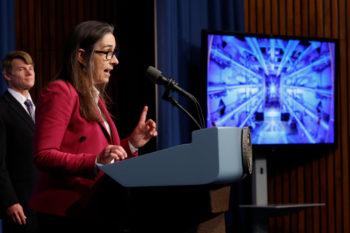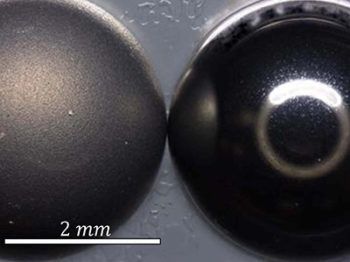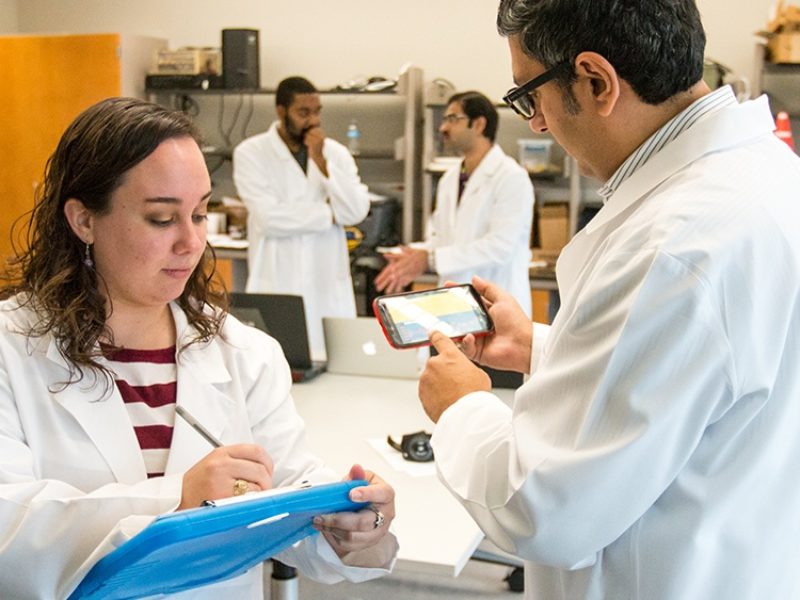Texas A&M Faculty Involved In Cutting-Edge Fusion Research Explain Recent Breakthrough

A recent fusion ignition test at the Lawrence Livermore National Laboratory (LLNL) is being hailed as a major step forward in the development of clean, fusion-powered generators which could one day meet the world’s energy needs without producing harmful waste and emissions.
This week, LLNL scientists announced they have performed the first-ever controlled fusion reaction to produce more energy than it took to create. As reported by the U.S. Department of Energy on Tuesday, the team used an array of powerful lasers to blast a peppercorn-sized capsule containing hydrogen isotopes with just over two million joules of energy, fusing them into helium and producing more than three million joules as a result.

Among the many scientists and engineers who contributed to this recent breakthrough are two faculty members from the Texas A&M University College of Engineering. Satish T.S. Bukkapatnam and Yu Ding, professors in the Wm Michael Barnes ’64 Department of Industrial and Systems Engineering, have been working with the Lawrence Livermore Lab’s National Ignition Facility, where the test was performed, since the spring of 2019.
Texas A&M Today spoke with Bukkapatnam and Ding about their involvement in the project and the global implications of this recent breakthrough.
What is nuclear fusion, and why is this announcement from Lawrence Livermore being called a major breakthrough?
Bukkapatnam and Ding: Nuclear fusion is a reaction that combines multiple atomic nuclei, producing one or more nuclei of a different element and releasing subatomic particles. Nuclear fusion releases a huge amount of energy in that process. The so-called ‘H-bomb’ explodes as a result of uncontrolled nuclear fusion. The LLNL facility uses the laser-driven inertial confinement fusion (ICF) mechanism, which concentrates 192 powerful laser beams for igniting a mixture of hydrogen isotopes, including deuterium and tritium, contained in a fuel capsule of the size of a peppercorn to create a fusion reaction.

While the principle of ICF has been known for years, making it work takes a lot of effort. The first breakthrough experiment in fact took place in August 2021, slightly more than one year ago. Then, in an experiment using the same facility, LLNL confirmed that a nuclear fusion indeed took place.
In the 2021 experiment, the fusion energy output was smaller than the laser energy input. The significance of this year’s experiment on Dec. 5 is that the fusion energy output is actually 1.5 times greater than the input. This is the first time ever that scientists have been able to produce more energy than the immediate laser energy input in a controlled fusion process. It is a necessary step toward making use of nuclear fusion for energy production.
What has been your involvement in the LLNL’s fusion research?
The Texas A&M team, consisting of ourselves and multiple graduate students (notably, Bhaskar Botcha, Shilan Jin and Akash Tiwari), works with LLNL colleagues on the polishing of the fuel capsule used in the ignition leading to nuclear fusion.
The capsule is essentially a spherical shell of roughly two millimeters in diameter used to hold the fuel for fusion. The capsule obviously plays a critical role in the ignition experiment, and its surface quality is one of the key factors leading to the success of the fusion. The majority of the time and effort in making these fuel capsules goes into polishing their surfaces.
The capsule is made of multiple layers of different materials. Its outermost layer is coated with diamond. The diameter of the capsule, the thickness of different layers and the shape of the capsule should be precisely controlled. Its surface needs to be polished to the level of 10-20 nanometers in roughness and to be absent of large pits, cracks and other defects. This is a very high-precision requirement of surface smoothness.

Our team focused on instrumenting the polishing machines with sensors and developing algorithms to analyze the data from these sensors and other instruments for observing and assessing the surface quality of the fuel capsules.
The increased emphasis on quality assurance is leading to the manufacture of the fuel capsules with fewer pits and defects. This has contributed to the higher energy outputs from the inertial confinement fusion experiments (laser “shots”), and increased repeatability of the experiment outcomes. The team also investigating methods to reduce overall polishing efforts as well as to gain a fundamental understanding of the defect formation mechanisms and the pathways to control them.
What are some potential benefits of using fusion as an energy source and when could it happen?
There are a lot of advantages if, one day, fusion can provide energy for our daily use. The current nuclear power plants are based on fission, which is to split atoms. The fission process produces radioactive by-products that are difficult to store and process. Incidents involving fission-based nuclear power plants are usually disastrous and their clean-up is difficult, costly and dreadful.
Fusion-based power plants do not have these problems. There are no serious radioactive by-products, and fusion uses hydrogen isotopes as the fuel, which are abundant in nature, so much so that people claim that if the fusion energy production becomes reality, the world will simply have unlimited cheap and clean energy. Incidents involving fusion power plants are much less dangerous.
We are unfortunately decades away from making fusion energy production a reality. Although the immediate laser energy input in the recent test is 2.05 MJ (million joules), the whole process to produce these powerful laser beams consumed much more energy — around 300-400 MJ. In the end, the process produces 3.15 MJ. So in other words, the energy efficiency of the facility, as of today, is below 1%.
What does this successful test mean for the future of fusion research?
This is the first time humankind has ever produced more energy than the immediate laser energy input, a very important and necessary step toward any future commercial production.
It was noted that the carbon footprint of nuclear fusion, under steady state, is likely to be negligible compared to that of any fuel.
For commercial production, one needs to produce more energy than the total amount consumed. It must be noted that the 3.15 MJ was generated within a matter of several nanoseconds. Advances in sciences, in addition to the technologies to design and manufacture ICF reactors, will be needed to create a new generation of reactors capable of sustaining these energy outputs shot after shot.
Is there anything else people should know about this development?
This breakthrough is certainly a moonshot of modern times. It has already energized young entrepreneurs to explore startup ventures toward the further development and commercialization of this technology.
The success is a result of the hard work a large team of researchers from different disciplines working as a team of teams. While the contribution of nuclear scientists is quite evident, those of other disciplinary experts is quite vital. In particular, our collaborations during the past two years opened us to some exciting challenges for researchers in manufacturing domain, as well as some interesting possibilities for advances in smart manufacturing and data sciences to tackle some of these challenges.
We hope that the attention to this breakthrough helps motivate the young generation and attract them to science and technology. Doing science is hard but exciting. We hope that more girls and boys in this country will consider STEM majors when they grow up.





